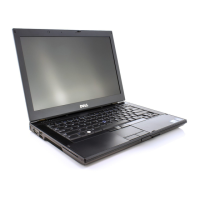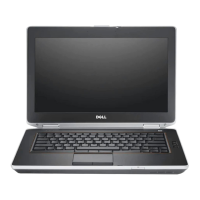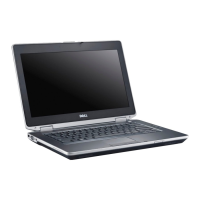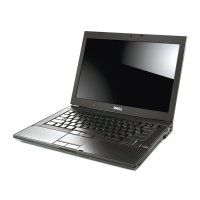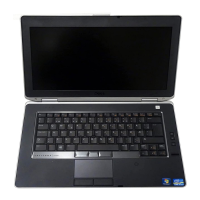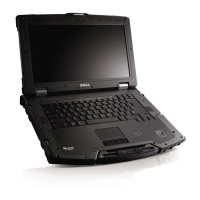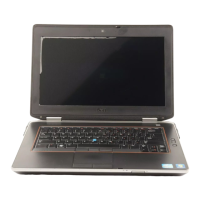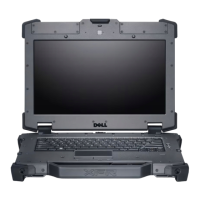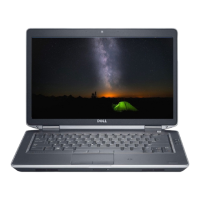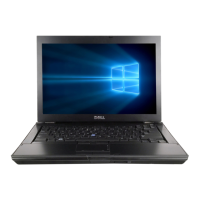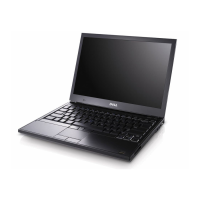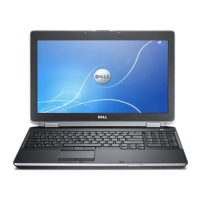Do you have a question about the Dell Latitude E6440 and is the answer not in the manual?
Safety guidelines and preparation before internal access to the computer.
Procedure for properly shutting down the operating system before maintenance.
Steps to reconnect components and power on after internal work.
Visual identification of internal computer components.
Procedure to remove the main battery from the computer.
Procedure to install the main battery into the computer.
Steps to remove the computer's primary storage drive.
Steps to install the computer's primary storage drive.
Procedure to remove the keyboard assembly.
Procedure to install the keyboard assembly.
Procedure to remove the main motherboard.
Procedure to install the main motherboard.
Procedure to remove the LCD screen panel from the display assembly.
Procedure to install the LCD screen panel into the display assembly.
Configuring the order of devices for system startup.
Overview of various configurable hardware and system settings.
Setting and managing the administrator password in BIOS.
Setting and managing the system login password in BIOS.
Overview of securing the system with BIOS passwords.
Steps to set or change BIOS passwords for system security.
Steps to remove or modify BIOS passwords.
Running built-in hardware diagnostic tests before OS loading.
Interpretation of various LED indicator lights on the computer.
Interpretation of battery charging and status indicator lights.
Core hardware details like chipset and BIOS version.
Details regarding the CPU type and cache.
Details regarding RAM type, capacity, and slots.
Specifications for graphics controller and display outputs.
Details of all external ports and connectors on the computer.
Specifications for the LCD panel, resolution, and brightness.
Specifications for the different battery types.
Physical dimensions and weight of the laptop.
Safety guidelines and preparation before internal access to the computer.
Procedure for properly shutting down the operating system before maintenance.
Steps to reconnect components and power on after internal work.
Visual identification of internal computer components.
Procedure to remove the main battery from the computer.
Procedure to install the main battery into the computer.
Steps to remove the computer's primary storage drive.
Steps to install the computer's primary storage drive.
Procedure to remove the keyboard assembly.
Procedure to install the keyboard assembly.
Procedure to remove the main motherboard.
Procedure to install the main motherboard.
Procedure to remove the LCD screen panel from the display assembly.
Procedure to install the LCD screen panel into the display assembly.
Configuring the order of devices for system startup.
Overview of various configurable hardware and system settings.
Setting and managing the administrator password in BIOS.
Setting and managing the system login password in BIOS.
Overview of securing the system with BIOS passwords.
Steps to set or change BIOS passwords for system security.
Steps to remove or modify BIOS passwords.
Running built-in hardware diagnostic tests before OS loading.
Interpretation of various LED indicator lights on the computer.
Interpretation of battery charging and status indicator lights.
Core hardware details like chipset and BIOS version.
Details regarding the CPU type and cache.
Details regarding RAM type, capacity, and slots.
Specifications for graphics controller and display outputs.
Details of all external ports and connectors on the computer.
Specifications for the LCD panel, resolution, and brightness.
Specifications for the different battery types.
Physical dimensions and weight of the laptop.
| Form factor | Clamshell |
|---|---|
| Product type | Laptop |
| Product color | Black, Silver |
| Market positioning | Business |
| Bus type | DMI2 |
| Tjunction | 100 °C |
| Processor cache | 3 MB |
| Processor cores | 2 |
| Processor model | i5-4310M |
| System bus rate | 5 GT/s |
| Processor family | Intel® Core™ i5 |
| Processor series | Intel Core i5-4300 Mobile series |
| Processor socket | Socket G3 |
| Processor threads | 4 |
| Processor codename | Haswell |
| Processor frequency | 2.7 GHz |
| Processor cache type | Smart Cache |
| Processor lithography | 22 nm |
| Processor manufacturer | Intel |
| Processor front side bus | - MHz |
| PCI Express slots version | 3.0 |
| Processor boost frequency | 3.4 GHz |
| Processor operating modes | 64-bit |
| ECC supported by processor | No |
| PCI Express configurations | 1x16, 2x8, 1x8+2x4 |
| Thermal Design Power (TDP) | 37 W |
| Maximum number of PCI Express lanes | 16 |
| Motherboard chipset | Intel® QM87 |
| Memory slots | 2x SO-DIMM |
| Internal memory | 8 GB |
| Memory clock speed | 1600 MHz |
| Memory form factor | SO-DIMM |
| Internal memory type | DDR3L-SDRAM |
| Maximum internal memory | 16 GB |
| Memory layout (slots x size) | 2 x 4 GB |
| LightScribe | - |
| AC adapter included | Yes |
| Disc types supported | CD, DVD |
| Storage media | Hybrid-HDD |
| Optical drive type | DVD±RW |
| Hybrid-HDD cache type | Flash |
| Total storage capacity | 500 GB |
| Compatible memory cards | SD, SDHC, SDXC |
| Display surface | Matt |
| Display diagonal | 14 \ |
| Display resolution | 1600 x 900 pixels |
| Native aspect ratio | 16:9 |
| Discrete graphics card model | AMD Radeon HD 8690M |
| On-board graphics card model | Intel® HD Graphics 4600 |
| Discrete graphics card memory | 2 GB |
| Discrete graphics memory type | GDDR5 |
| On-board graphics card family | Intel® HD Graphics |
| On-board graphics card OpenGL version | 4.3 |
| On-board graphics card base frequency | 400 MHz |
| On-board graphics card DirectX version | 11.2/12 |
| Number of discrete graphics cards installed | 1 |
| On-board graphics card dynamic frequency (max) | 1250 MHz |
| Audio system | HD |
| Wi-Fi standards | 802.11a, 802.11g, Wi-Fi 4 (802.11n) |
| Bluetooth version | 4.0 |
| Ethernet LAN data rates | 10, 100, 1000 Mbit/s |
| Charging port type | DC-in jack |
| USB 2.0 ports quantity | 0 |
| Pointing device | Touchpad |
| Trial software | Microsoft Office |
| Operating system installed | Windows 7 Professional |
| Processor ARK ID | 80373 |
| Processor package size | 37.5 x 37.5 x 4.7 mm |
| Supported instruction sets | AVX 2.0, SSE4.1, SSE4.2 |
| Battery capacity | 60 Wh |
| Battery life (max) | - h |
| Number of battery cells | 6 |
| AC adapter power | 65 W |
| Cable lock slot type | Kensington |
| Password protection type | BIOS |
| Cables included | AC |
| Sustainability certificates | ENERGY STAR |
| Certification | BFR/PVC-Free |
| Depth | 232.6 mm |
|---|---|
| Width | 338 mm |
| Height | 31.8 mm |
| Weight | 2120 g |
